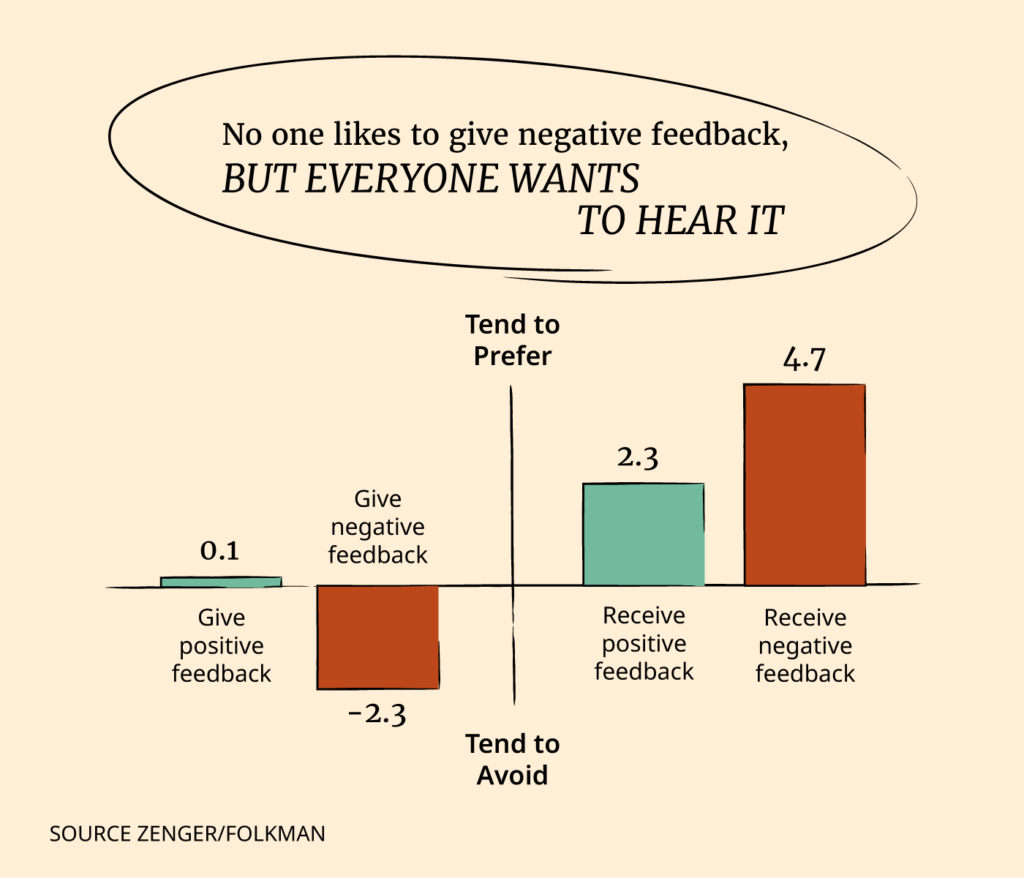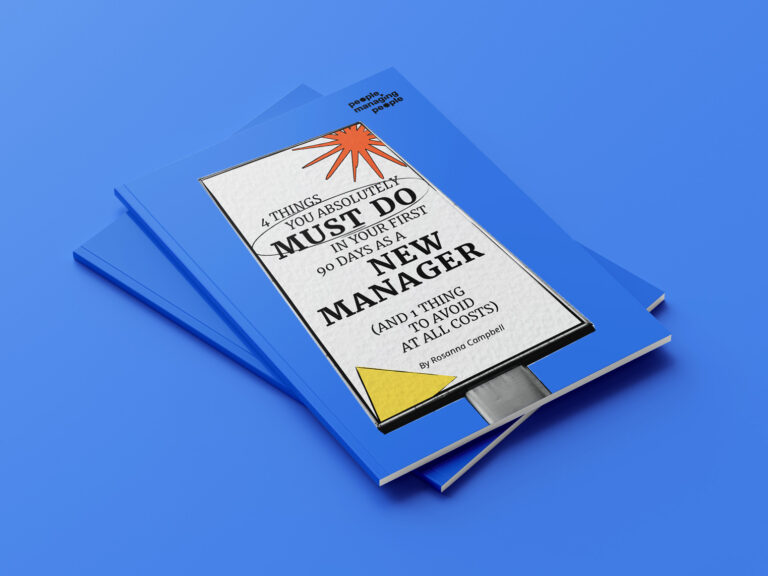Feel like you don’t know how to have difficult conversations with employees? You’re not alone.
Interact, a communications consultancy, surveyed over 2,000 managers to find out which conversations made managers most uncomfortable.
They asked managers if they found it more awkward to give negative feedback, show vulnerability, deliver the “company line”, or even just give clear directions to their team.
The result?
By a significant margin, managers were most uncomfortable with… communicating in general.
Yup, that’s right. More than two-thirds of managers would prefer to simply not communicate with their teams at all.
This is pretty worrying, frankly. The entire premise of performance management is based on constructive conversations between managers and their direct reports.
Employees who receive frequent and meaningful feedback are four times more likely to be engaged at work, and 3.6 times more likely to feel motivated to do their best work.
If the majority of managers dislike giving feedback—or even, apparently, just talking to their team—then it’s unsurprising that most employees want more feedback, and more than one in three feel unappreciated.
So, if you’re a manager, new or otherwise, who wants to be able to handle difficult conversations and get the best from your team, this article’s for you. We’ll walk you through:
- Why making the effort to give feedback is so important
- How to prepare for a tough conversation with an employee
- Examples of what to say and do during an awkward or uncomfortable discussion–and what not to say
Why managers need to know how to have difficult conversations?
There’s no question—giving tough feedback makes most of us uncomfortable. Unfortunately, the workplace offers no end of opportunities for challenging conversations, and avoiding them is likely to make matters worse.
Managers need to learn how to have awkward conversations because:
Employees benefit from negative feedback–and many prefer it to praise
According to research by leadership consultants Jack Zenger and Joseph Folkman, nearly three-quarters of people believe that their performance is improved by corrective feedback. In fact, the same study found that employees actually want negative feedback.
Fully 92% of the respondents agreed that “Negative (redirecting) feedback, if delivered appropriately, is effective at improving performance.”

Regular check-ins with your team can help their mental health
Frequent one-to-ones with your employees can reduce the risk of burnout, dramatically improve their engagement and job satisfaction, and make sure that they feel more understood and supported.
Your employees’ behavior and performance affects others around them
As a manager, you have a responsibility to help your team succeed and thrive. An underperforming, difficult or disengaged employee will often make other team members’ lives harder, and can create a dysfunctional team environment.
So, painful as they can be, having difficult conversations is part and parcel of being a good manager. Next let’s explore how you can approach them effectively.
Pro Tip: Leaders can use HR case management tools to document and manage conflict resolution around difficult conversations.
How to have difficult conversations with employees
Certain conversations are never going to be comfortable, and giving someone negative feedback is one of them. However, there are ways that you can make things easier for both parties.
1. Create a feedback culture
If negative feedback comes out of the blue, then your team member may well be shocked and upset. However, if the work environment encourages ongoing feedback, both positive and negative, then you’re less likely to need to have a formal sit-down every time something goes wrong.
As a rough rule of thumb, aim to give your direct reports 5 pieces of positive feedback for every piece of constructive criticism. Research suggests that this is the ideal ratio for high-performing teams.
2. Consider what outcome you want
But let’s say that you do need to have a more serious performance discussion with an employee. Start by becoming extremely clear and honest with yourself about the outcome you want from the discussion. Do you want the employee to change their behavior? If so, how exactly?
For instance, if the employee is constantly late, why is that an issue? Is it just something that bothers you on an emotional level, or is it causing inconvenience to you or the rest of the team? Do you need them to arrive on time every day, or just when there’s a morning meeting?
The reason this is important is that you might discover that you’re having the conversation for the wrong reasons. Imagine, for example, that you hadn’t even noticed that they arrived 5 minutes late every day, but that it is bothering one of their co-workers. You’re far less likely to handle the conversation well if your only real desired outcome is for the conflict to go away!
3. Get to know your own triggers
When you’re preparing for a hard conversation with an employee, you may focus on how they will react. Will they be upset? Will they argue with you?
However, you’d be better off thinking about your own responses in similar situations. What are your main trigger points? How do you behave when under stress? How do you feel about conflict? Do you have bad memories about other stressful conversations that might impact how you deal with this one?
You can’t control how your employee will react. But, by reflecting on your own reactions in advance, you’ll be better prepared to handle any emotions that come up during the conversation.
4. Acknowledge your own subjective reactions
One of the biggest issues with standardized performance reviews is the idiosyncratic rater effect—the fact that more than half of our ratings of someone else reflect our own characteristics, not those of the person we’re rating.
Studies show that this same skewing effect can happen when we try to give feedback to an employee in person. We can’t kid ourselves that we’re providing them with an objective insight into the truth of their poor performance. We’re simply telling them what we feel, perceive and think about their performance—from our own biased perspective.
As a result, 1) they’re more than likely to disagree with our point of view and 2) there’s a very good chance that they’re right and we’re wrong!
So, instead of leaping into a difficult conversation by informing the employee about what the issue is, it’s both more helpful and more accurate to share your fact-based observations with them, and then ask detailed questions.
Instead of telling an employee they need to improve their sales pitch, for instance, you could say: “I’ve noticed that your sales numbers are lower than expected. What do you think is going on?” .
5. Ask good questions
If you want the employee to improve a performance issue, then simply telling them about the issue is not enough. You need them to find ways to solve the problem and motivate them to actually want to solve it.
The only way to do this is to understand what’s causing the issue in the first place. But leaping in with the “Whys” (“Why did you do that?” “Why didn’t you tell me earlier?”) is likely to put the employee on the defensive.
Instead, you need to start by listening.
Let’s say your team member has just told you that a critical project is running two months late. Instead of asking “Why has that happened?”, try asking them to narrate the issue so you can help to pinpoint the exact cause of the problem.
For example: “OK, walk me through what happened. At what stage did the project start to become delayed? And then what happened next? What do you think the issue was?”
That way, instead of criticizing the employee, you are in a position to help them do better next time.
6. Acknowledge your own responsibility
It may be time to have an awkward conversation with yourself too. Team performance reflects manager characteristics to a surprising degree.
Research by BetterUp found that managers with low strategic thinking had much less innovative teams, managers who lacked resilience dragged team performance down, and managers with low cognitive agility (the ability to shift perspectives) also had teams with lower agility.
Unfortunately, the cause of the issue may be you!
But there’s no need to panic. Simply take responsibility for your share of the issue before you get into a discussion. For example: “I notice that this project is extensively delayed. I’m concerned that I didn’t give you a realistic deadline, and I may have underestimated how complex the project was. Could you walk me through what happened?”
This will make the employee feel far less defensive, and more likely to have an honest conversation with you. It shifts the power dynamic–instead of a superior scolding an employee, you become two people solving a shared problem so it’s not repeated.
7. Avoid emotional contagion
If you’re giving an employee bad news, they may well become emotional. This is entirely natural in this type of conversation—but as a manager you may find it stressful.
For instance, Deborah Grayson Riegel, a leadership communication coach, notes that we tend to find it upsetting when an employee cries during a difficult conversation because we worry we may be the cause or instinctively want to fix it.
There’s also the issue of emotional contagion. Emotions are contagious so, if the employee becomes angry or upset, we may well find ourselves copying their reactions. This is unhelpful, to say the least!
When managing an employee who is underperforming, it's normal for them to become upset when you confront them about their performance—they may feel worried they’ll lose their job, embarrassed at their failure, or disappointed that they aren’t delivering the results they’d hoped for.
However, as the manager, your role is to help them regulate those difficult emotions by remaining calm and supportive and not allowing your own emotions to mimic theirs.
If you find yourself becoming emotional, return to the task at hand by concentrating on the outcomes you need from the conversation.
If a team member becomes angry, tearful, or depressed during your conversation, Grayson Riegel advises the following:
- Use neutral language and state what you see, but don’t tell them how they’re feeling. For instance, instead of saying “I can see you’re very sad”, try “I can see that you’re crying. Would you like to take a break or shall we keep going?”
- Demonstrate compassion and curiosity. For example, “Could you tell me what you’re thinking at this point?” or “What would be most helpful for you right now?”
How to give negative feedback (with examples)
Here are a few phrases you might find helpful during a difficult conversation—and a few you might want to avoid!
| Instead of saying: | Try Saying: |
|---|---|
| Why did this go wrong? | Can you walk me through what happened? |
| You need to improve your communication skills. | Here’s something I didn’t understand in your last presentation. |
| Please don’t cry. | I can see you’re crying. Would you like to take a break or keep going? It’s up to you. |
| I can see you’re upset–I’m pretty upset too right now! | You seem upset–have I got that right? Could you tell me what you’re thinking right now? |
| You keep coming in late and it’s a real issue for the team. | You were late for yesterday’s meeting and you missed Claire’s update. Could you ask her to bring you up to speed? |
| You need to be more professional on the phone. | When you answer the phone like that, I feel x… |
| You need to work on your relationships with the rest of the team. | I notice that you don’t interact much in the group chat. Can you tell me more about that? |
| You keep missing deadlines and it’s holding back the rest of the team. You need to improve your time management. | I notice that you missed the last two deadlines. What’s the best way I can help? |
It’s time to get comfortable with uncomfortable conversations
If you want to be a great manager, there will be times when you have to have difficult conversations.
Whether you’re giving a negative performance review, resolving a team conflict, or even letting someone go, it’s never going to be easy—but preparation, practice and perspective can help.
As always, best of luck.

The New Manager Handbook
Hard-learned words of wisdom from seasoned people managers to those just starting out.
Some further, resources to help you become a better manager:
- From Friend To Boss: How To Establish Authority & Set Boundaries As A New Manager
- In Too Deep: How To Keep Calm & Carry On When You’re Overwhelmed As A New Manager
- 8 Effective Ways To Get Employee Feedback (+ Pros and Cons)
- 5 Methods To Help You Deal With Difficult Team Members
- 5 Ways To Give More Effective Feedback
- How To Go From Manager To Coach
- How To Master Self-Leadership To Become A Better Leader (with Dave Ulrich)




